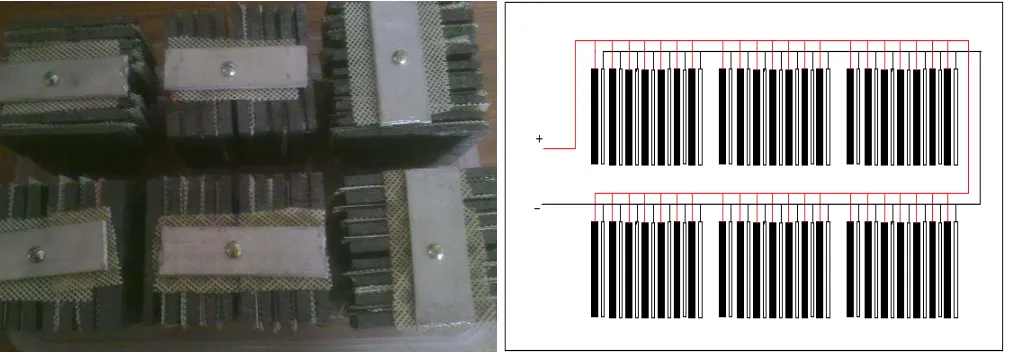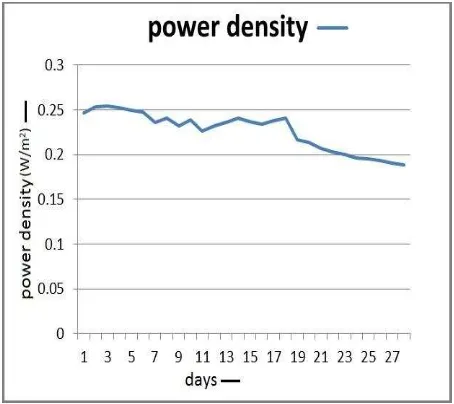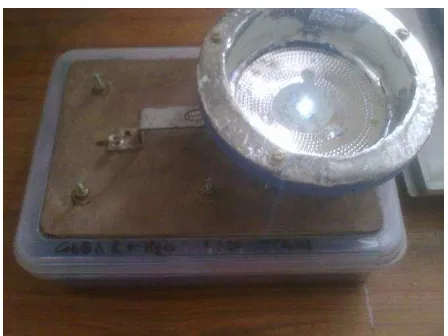Int. Journal of Renewable Energy Development 2 (1) 2013: 31-34
P a g e | 31
© IJRED – ISSN: 2252-4940, 15 February 2013, All rights reserved
Contents list available at IJRED website
Int. Journal of Renewable Energy Development (IJRED)
Journal homepage: www.ijred.com
A Novel Design of Multi-Chambered Biomass Battery
K. Sudhakar
*a, R. Ananthakrishnan
a, A. Goyal
a, and H.K. Darji
b
a Department of Energy, M.A.N.I.T. Bhopal 462051, Madhya Pradesh, INDIA
bProject Engineer, Flareum Solar Technology Pvt Ltd, Delhi, INDIA
Article history:
Received Oct 28, 2012
Received in revised form Dec 8, 2012 Accepted Jan 5, 2013
Available online
ABSTRACT: In this paper, a novel design of biomass battery has been introduced for providing electricity to meet the lighting requirements of rural household using biomass. A biomass battery is designed, developed and tested using cow dung as the raw material. This is done via anaerobic digestion of the cow dung, and power generation driven by the ions produced henceforth. The voltage and power output is estimated for the proposed system. It is for the first time that such a high voltage is obtained from cow dung fed biomass battery. The output characteristics of this novel battery design have also been compared with the previously designed battery.
Keywords: anaerobic-digestion, biomass battery, cow dung fed biomass battery, energy storage, renewable energy
*
Corresponding author: Tel: +91-755-4051000, Fax: +91-755-2670562 E-mail: sudha_k@sify.com
1. Introduction
Increasing energy needs and depleting fossil fuel sources resulted in the quest for new energy sources. This has raised a great interest in Biomass sources as a possible candidate for long-term, sustainable, energy generation. Bio-energy is now accepted as having the potential to provide a major part of the projected renewable energy provisions of the future (Schuck 2006; Kaygusuz 2009). It has been reported that organic waste can be a major sources of renewable energy (Mano et al. 2003; Liu et al. 2004; Shukla et al. 2004; Rabaey & Verstraete 2005; Lovely 2006; Logan & Regan 2006). Aquatic weeds have also been used as biomass for the production of energy (Sudhakar et al. 2013). In this direction, microbial fuel cells technology for bioelectricity generation is being studied extensively (Rabaey et al. 2003; Jang et al. 2004; Min & Logan 2004; Liu et al. 2005). Microbial fuel cells (MFCs) are devices that can use bacterial metabolism to produce an electrical current from wide range organic substrates (Dalvi et al. 2011). It results from the conversion of chemical energy into electrical energy. The bioelectrical current is a flow of ions (atoms or molecules carrying an electric charge), while standard electricity is a
movement of electrons. Bioelectricity can be generated when we use two electrodes with different potential immersed in a biomass substrate.
Reactions taking place in the biodegradation of a biomass is:
C6H12O6 + 6H2O = 6 CO2 + 24 H+ + 24 e CH3COOH + 2H2O = 2 CO2 + 8 H+ + 8 e
-Cow dung has the potential to serve as a means to generate electricity in many remote villages. Cow excreta have been identified as viable source of energy with additional quality that greenhouse emissions are reduced significantly.
Citation: Sudhakar, K., Ananthakrishnan, R., Goyal, A. & Darji, H.K.(2013)A Novel Design of Multi-Chambered Biomass Battery. Int. Journal of Renewable Energy Development, 2(1), 31-34
P a g e | 32
© IJRED – ISSN: 2252-4940, 15 February 2013, All rights reserved Fig. 1 Biomass battery arrangement
follows the principle of a chemical fuel cell. Biomass battery uses zinc plate and graphite electrodes to convert substrate into electricity through biological process. The Biomass battery setup is shown in Fig. 1. Due to the anaerobic decompositions, voltage difference is obtained at the two terminals. This voltage output can be used to power LED lamp for lighting after dusk. Graphite plate acts as anode positive pole and Zinc plate as cathode of battery. The aim of present study was to investigate the possibility of sustainable power generation which can be relied on.
2. Experimental
2.1 Design
A plastic container having six chambers has been used. Every section comprises of a small grid. These six grids are placed in series. Each grid comprises of seven pair of electrodes placed in parallel as shown in Fig. 2. In every grid the graphite anode and zinc cathodes are placed in parallel. This parallel combination is used to strengthen the voltage output of a single grid and to increase the current of the whole setup. Whole setup of
parallel grids is screwed to the container lid. This enables easy filling and emptying of the container. The connecting wires are connected to two output ports present at the outside of this lid. Output voltage can be obtained from these output ports. Space has been provided between the grids and bottom surface of the battery which allows uniform spreading of the biomass substrate.
Table 1 Specifications
Substrates Cow Dung, Water
Hyacinth Anode and cathode material Graphite plate & zinc plate Surface area of each plate of electrodes 35 (sq. cm)
Total surface area of zinc plate 3360 cm2
Feeding nature (L/cycle) Batch 0.75
2.2 Analytical Methods
Cow dung was obtained from the nearby village in MANIT district. Cow dung was mixed with water in the ratio 1:4, which was then used as the biomass substrate. 0.75 L of cow dung mixture was fed to the biomass battery. It was assured that substrate spreads evenly.
2.3 Life Cycle Cost Analysis
Current (I), potential (V) and internal resistance (R) measurements were recorded using digital multi-meter (Metravi 901). Power (W) was calculated using the equation P=IV, where I is in amperes and V is in mV. Power density (W/m2) was calculated by dividing the obtained power with the surface area (sq.m) of the battery. The biomass battery was continuously monitored during experiment and readings were taken for 28 days, inoculation time was considered as day 0. The output voltage, current, internal resistance, power density and are compared for different substrates.
Int. Journal of Renewable Energy Development 2 (1) 2013: 31-34
P a g e | 33
© IJRED – ISSN: 2252-4940, 15 February 2013, All rights reserved
3. Result and Discussion
The current was produced instantaneously and there was no delay. Fig. 3 shows the output voltage of the biomass battery for the first day.
Fig.3. Output voltage display
The output voltage obtained was stable throughout the span of 28 days. It fluctuated from a maximum of 3.80V to a minimum 3V recorded on the 28th day. On the 17th day maximum voltage of 3.80V was recorded and maximum power density of 0.253W/m2 was recorded on 2nd day. The output voltage gradually increased till the 17th day and then continuous decrease was obtained as shown in Fig. 4. The output power density also showed a similar response with an increase in the initial days and then a decrease in the later period of observation (Fig. 5).The major feature of the technology is the continuous power is obtained up to 28 days till the slurry undergoes complete digestion. The output voltage is continuously above 3V throughout the tenure of observation. An average voltage of 3.41V can be obtained from this battery. With this output LED lamps (3 volt) can be illuminated for about 28 days or more without changing the substrate (Fig. 6.). A group of LED lamps can be used for lighting in villages after the dusk. Experimental data showed the feasibility of electricity generation from cow dung using this novel approach.
The cost economics of Biomass battery is listed in Table 2. The production cost of a biomass battery primarily consists of the cost of its raw materials, cost of which very much within economical range. A six compartment plastic container can be procured from any hardware store and costs Rs. 55. Scrap graphite blocks were bought from HEG, Mandideep; a company that manufactures electrodes. The cost of per kilogram is Rs.27 and the total requirement was of 4 kg (based on the density). Thus, total cost of scrap graphite blocks was Rs.108. Zinc plates were bought from a scientific instruments store and the cost per kg was Rs.305. Total
requirement of Zinc plates was of 1 kg. The manufacturing costs include the cost of cutting (e.g. labor charges) graphite blocks and zinc plates and amounted to Rs.50. The production cost of a biomass battery is the sum of these raw material cost and manufacturing cost which amounted to Rs.518.
A biomass battery has numerous advantages over conventional batteries. Its cost of production is low because of inexpensive raw materials and negligible manufacturing costs. It renders the surroundings clean and is itself eco-friendly in operation. It is easy to handle, is portable and there is no need to replace the cow dung every day. It can continuously generate power without the need of an external source of power.
It has a relatively longer life compared to other similar batteries. It has practical applications in rural areas for LED lighting and in remote areas.
Fig. 4 Output voltage vs day
Citation: Sudhakar, K., Ananthakrishnan, R., Goyal, A. & Darji, H.K.(2013)A Novel Design of Multi-Chambered Biomass Battery. Int. Journal of Renewable Energy Development, 2(1), 31-34
P a g e | 34
© IJRED – ISSN: 2252-4940, 15 February 2013, All rights reserved Fig. 6 Biomass battery powering a light source
Table 2 Cost Calculation
S. No
Description Rate Quantity Amount
1. Plastic container with six compartment
Rs 55 each 1 55
2. Scrap Graphite blocks (7cm x 7cm x 7.5cm)
Rs 27/kg 4 kg 108
3. Zinc plate (7cm x 5cm) Rs 305/kg 1kg 305
4. Miscellaneous 50
Total: Rs.518
4. Conclusion
Under present investigation, electricity was successfully generated with cow dung as raw material using Biomass battery technology. The biomass battery fuel cell technology is cost-effective and environmentally sound and sustainable solution for rural villages. The maximum possible power density obtained is 0.25 W /m2. The maximum possible voltage obtained is 3.8 V. The Biomass fuel cell technology is still in an early stage of development, but shows great promise as a new method to accomplish both energy
storage and electricity generation. Biomass battery technology may provide a new method to generate electricity for rural household, making the technology more affordable for rural electrification.
References
Dalvi, A.D., Mohandas, N., Shinde, O.A., and Kininge, T.P. (2011) Microbial fuel Cell for Production of Bioelectricity from Waste and Biological Waste Treatment, IJABR, 2 (2), 263-268
Jang, J.K., Pham, T.H., Chang, I.S., Kang, K.H., Monon, H.J., Cho, K.S. and Kim, B.H. (2004) Construction and operation of a novel mediator and membrane-less microbial fuel cell. Proc. Biochem., 39, 1007– 1012
Kaygusuz, K. (2009) Bioenergy as a Clean and Sustainable Fuel.
Energy Sources Part A, 31 (12), 535-545.
Liu, H., Cheng, S., and Logan, B.E. (2005) Production of electricity from acetate and butyrate using a single-chamber microbial fuel cell.
Environ. Sci. Technol., 39 (14), 658–662.
Liu, H., Ramanarayanan, R., and Logan, B.E. (2004) Production of electricity during wastewater treatment using a single chamber micro-bial fuel cell. Environ. Sci. Technol., 38(11), 2281–2285. Logan, B.E. and Regan, J.M. (2006). Microbial challenges and fuel cell
applications. Environ. Sci. Technol., 40(17), 5172–5180.
Lovely, D.R. (2006) Bug juice: Harvesting electricity with microorganisms. Nature Rev. Microbiol., 4 (10), 497–508.
Mano, N., Mao, F., and Heller, A. (2003) Characteristics of a miniature compartment-less glucose-O2 biofuel cell and its operation in a living plant. J. Am. Chem. Soc., 125 (21), 6588–6594.
Min, B., and Logan, B.E. (2004) Continuous electricity generation from domestic wastewater and organic substrates in a flat plate micro-bial fuel cell. Environ. Sci. Technol., 38 (21), 5809–5814.
Rabaey, K., Lissens G, Siciliano SD, and Verstraete W (2003) A micro-bial fuel cell capable of converting glucose to electricity at high rate and efficiency. Biotechnol. Lett., 25 (18), 1531–1535.
Rabaey, K., and Verstraete, W. (2005) Microbial fuel cells: Novel biotechnology for energy generation. Trends Biotechnol., 23 (6), 291–298.
Schuck, S. (2006) Biomass as an energy source. Int. J. Environ. Stud. 63 (6), 823-835.
Shukla, A.K., Suresh, P., Berchmans, S., and Rajendran, A. (2004) Biological fuel cells and their applications. Curr. Sci. 87 (4), 455– 468


